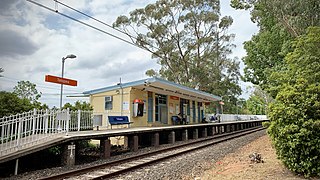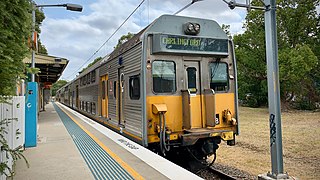
Carlingford is a suburb of Sydney, in the state of New South Wales, Australia. Carlingford is 22 kilometres north-west of the Sydney central business district in the local government area of City of Parramatta. Carlingford is in the Hills District and Northern Sydney regions.

Westmead is a suburb in Sydney, in the state of New South Wales, Australia. Westmead is located 26 kilometres west of the Sydney central business district in the local government area of Cumberland Council and is part of the Greater Western Sydney region.
Dundas is a suburb of Sydney, New South Wales, Australia. Dundas is located 21 kilometres north-west of the Sydney central business district, in the local government area of the City of Parramatta, and the electoral division of Bennelong. Dundas is a leafy green suburb, notably due to its centrepiece The Ponds Walk, which follows the Ponds Subiaco Creek. Dundas is part of the Northern Sydney and Greater Western Sydney regions.

Dundas railway station, originally Kissing Point Road railway station, is a heritage-listed former railway station in Sydney, Australia, that was open between 1896 and 2020 and was located on the Carlingford line, serving the suburb of Dundas.

Rosehill railway station is a disused railway station in Sydney, Australia that is located next to Rosehill Gardens Racecourse. It was open between 1888 and 2020. It served passengers on the Sandown railway line until 1991, the Carlingford line until 2020, and special event services to the racecourse, as well as serving the local suburb of Rosehill.

Rydalmere(formerly "Field of Mars") is a suburb of Sydney, in the state of New South Wales, Australia. Rydalmere is approximately 21 kilometres west of the Sydney central business district in the local government area of the City of Parramatta. Rydalmere is part of the Greater Western Sydney region.

Carlingford railway station was a railway station in Sydney, Australia. It opened in 1896 and was the terminus of the Carlingford line, which served the suburb of Carlingford and was served by Sydney Trains T6 Carlingford line services. The Carlingford railway line was closed on 5 January 2020 with the station demolished in May 2020.

Lidcombe railway station is located on the Main Suburban line, serving the Sydney suburb of Lidcombe. It is served by Sydney Trains T1 Western, T2 Inner West & Leppington, T3 Bankstown and T7 Olympic line services.

Camellia railway station, originally Subiaco railway station, was a railway station in Sydney, Australia, that was open between 1885 and 2020. It was located on the Carlingford line, serving the suburb of Camellia and at the time of closure was served by Sydney Trains T6 Carlingford line services.

Rydalmere railway station, originally Victoria Road railway station, was a railway station in Sydney, Australia that was open between 1896 and 2020. It was located on the Carlingford line and served the suburb of Rydalmere. At the time of closure, Rydalmere station was served by Sydney Trains T6 Carlingford line services.

Telopea railway station was a railway station in Sydney, Australia, that was opened in 1925. It is located on the Carlingford line, and served the suburb of Telopea. It was served by Sydney Trains T6 Carlingford line services. The Carlingford railway line closed on 5 January 2020, and the station was demolished in May of that year

Telopea is a suburb of Greater Western Sydney, in the state of New South Wales, Australia. Telopea is located 23 kilometres north-west of the Sydney central business district, in the local government area of the City of Parramatta. The suburb is bordered by Kissing Point Road to the south and Pennant Hills Road to the north.

Clyde is a locality of Sydney, in the state of New South Wales, Australia. Clyde is located 21 kilometres west of the Sydney central business district in the local government area of the City of Parramatta. Clyde is part of the Greater Western Sydney region.

Clyde railway station is located on the Main Suburban line, serving the Sydney suburb of Clyde. It is served by Sydney Trains T1 Western and T2 Inner West & Leppington line services.

Sydney, the largest city in Australia, has an extensive network of passenger and freight railways. The passenger system includes an extensive suburban railway network, operated by Sydney Trains, a metro network and a light rail network. A dedicated freight network also exists. Future expansion of the light rail network includes the Parramatta Light Rail. Existing light rail services are the Inner West Light Rail and the CBD & South East Light Rail.

The Sandown Line is a short former industrial railway line in the western suburbs of Sydney, New South Wales, Australia. It began life as the Bennett's Railway, opening on 17 November 1888. The line diverges from the Carlingford line just south of Camellia station.

The Duck River is a perennial stream and southern tributary of the Parramatta River, in Sydney, New South Wales, Australia.

Sydney Trains is the operator of the suburban passenger rail network serving the city of Sydney, New South Wales, Australia. The network is a hybrid urban-suburban rail system with a central underground core that covers 369 km (229 mi) of route length over 813 km (505 mi) of track, with 170 stations on eight lines.

The Carlingford railway line was a railway line in Sydney, Australia. It was opened from Clyde to Subiaco in January 1885, then by means of the construction of a bridge across the Parramatta River, to Carlingford in April 1896. It closed on 5 January 2020 with much of the line to be converted to light rail as part of the Parramatta Light Rail network, while a short section of the line was retained for use by Sydney Trains.

The Parramatta Light Rail is a project for a twelve-kilometre (seven-mile) light rail line in Sydney, New South Wales, Australia, which is under construction and due to start passenger services in May 2024. The line will run from Westmead to Carlingford via the Western Sydney centre of Parramatta. The initial announcement of the project also included an eastern branch from Camellia to Strathfield. Plans to construct this branch were deferred in February 2017, and in October the original plans were replaced with a redesigned and truncated route to Sydney Olympic Park. The project will add to light rail in Sydney but the new line will be completely separated from the existing lines. It is being managed by Transport for NSW.






















